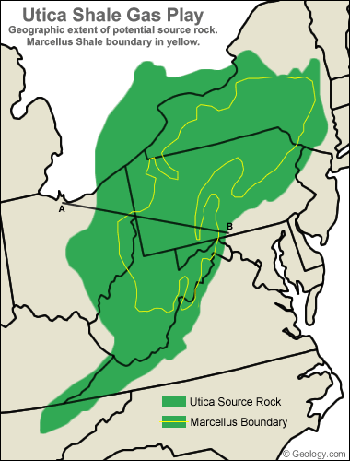Marcellus and Utica Shale

The Marcellus Shale is a deep natural gas reserve running under parts of New York, Pennsylvania, Ohio, West Virginia, Maryland, and Virginia. The Utica Shale is even deeper and larger, covering parts of these states plus Kentucky and Tennessee. For the last several years, the Marcellus has been the focus of a huge boom in exploration and extraction, and more recently activity has also started in the Utica. New drilling technologies, like the combination of hydraulic fracturing with horizontal drilling, have made these deposits—long considered too difficult and expensive to drill—accessible to the industry.
Some states open the door, others not
Currently, Pennsylvania, Ohio, and West Virginia are at the heart of the eastern shale gas leasing and drilling boom, with tens of thousands of wells drilled and thousands more already given permits. New York’s long environmental review process and a vibrant anti-fracking movement continue to delay a decision on allowing shale gas development. The process is also on hold in Maryland due to public opposition and state review.
Fracturing’s checkered history
Alongside a rapid increase in wells and political support for natural gas has been widespread public concern over health and environmental impacts—as well as a growing body of scientific evidence of water and air pollution from chemicals, industrial facilities, and waste. Loopholes in several national laws, outdated state regulations, and lax oversight and enforcement have made drilling much easier for industry—and life much harder for communities.
For more information:
EARTHWORKS' resources
- EARTHblog Get the lastest from our Eastern Program Coordinator, Nadia
- Shale Gas: focus on the Marcellus Shale
- Oil & Gas At Your Door? A Landowners Guide to Oil & Gas Development
- Surveys and reports on community health impacts
- Hydraulic Fracturing 101
- Response to New York State’s environmental impact statement and proposed regulations
Data & science
- The Endocrine Disruption Exchange natural gas research page
- New York Times Drilling Down investigative reporting series
- Propublica Fracking investigative reporting series
- FracTracker drilling impacts and data
- Public Herald’s Triple Divide film
State organizations
- West Virginia: WV Surface Owners Rights Organization, Wetzel County Action Group, WV Sierra Club
- Maryland: Citizen Shale, Maryland Fracking Moratorium Now, Chesapeake Climate Action Network
- Ohio: People’s Oil & Gas Collaborative, Ohio Environmental Council, OH Sierra Club
- New York: NY Water Rangers, New Yorkers Against Fracking, Concerned Health Professionals, Catskill Citizens for Safe Energy
- Pennsylvania: Campaign for Clean Water, PennEnvironment, Clean Air Council, Delaware Riverkeeper Network
Tagged with: shale gas, pennsylvania, marcellus shale, fracking, drilling
Follow Earthworks